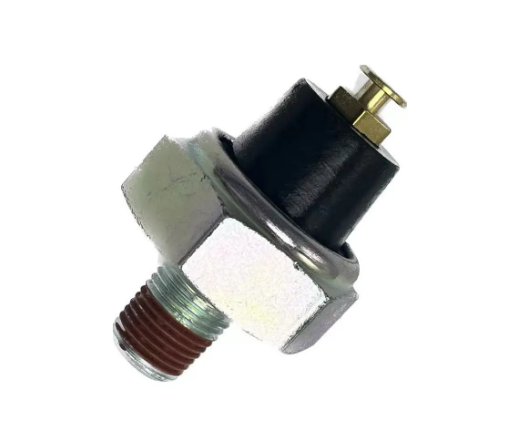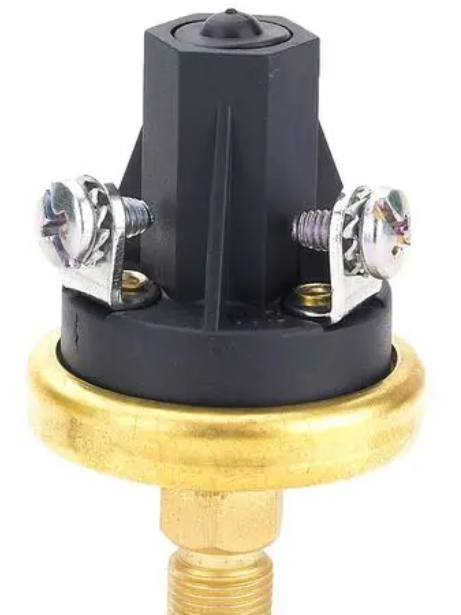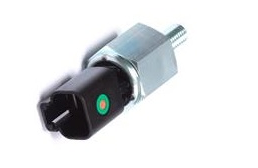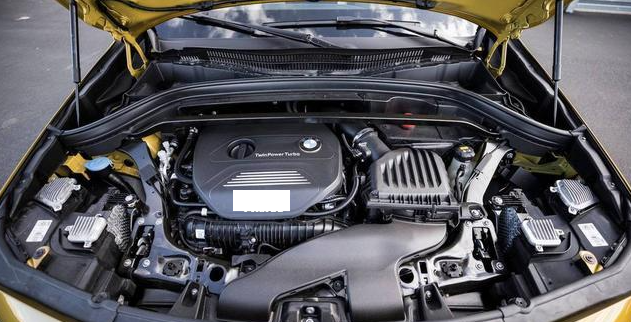What is an Oil Pressure Switch?

What Is an Oil Pressure Switch?
An oil pressure switch is a very important protection device for an engine. It functioning as a type of oil pressure sensor. It is a mechanical component equipped with an internal switch. Typically, oil pressure switches are designed to close when activated, signaling low oil pressure. This signal can be directed either to the engine block, serving as a ground, or through an insulated return path.

Types of Oil Pressure Switch
Oil pressure switches can also be classified based on their pin configuration. They are 1 pin, 2 pin and 3 pins, below is the detailed introduction to them.
1 Pin Oil Pressure Switch
The single pin oil pressure switch features a single electrical terminal used for connection. It primarily serves to provide a basic on/off signal to the vehicle’s electrical system. This simple design is common in older vehicles or engines where only a straightforward warning mechanism is required to indicate low oil pressure.

2-Pin Oil Pressure Switch
The two-pin oil pressure switch includes two electrical terminals: one for power supply or signal input and the other for output or ground. This configuration allows the switch to send a basic oil pressure signal to the dashboard or engine management system, facilitating basic monitoring and alerts in many standard vehicles.

3-Pin Oil Pressure Switch
Equipped with three electrical terminals, the three-pin oil pressure switch offers more functionality. Typically, one pin is used for connecting a warning light, another for sending a signal to the engine control unit (ECU), and the third for ground. This setup enables both visual alerts and data transmission to the ECU for enhanced engine management in modern vehicles.

What Does an Oil Pressure Switch Do?
The primary function of the oil pressure switch is to monitor the engine's oil pressure. When the oil pressure is within the safe range, the switch remains off. If the pressure drops, the switch activates and sends a warning light signal to the dashboard. This alert helps the driver take immediate action to avoid engine damage. Here are some other functions of oil pressure switch:
l Activates warning signals
l Protects the engine
l Prevents severe engine damage
l Supports modern vehicle systems
Oil Pressure Switch vs Oil Pressure Sensor
The oil pressure switch is primarily used for detecting and controlling pressure, converting the measured pressure into a binary signal output (on/off) or an analog signal (current or voltage). Its operation is based on the change of a physical quantity (like pressure) which triggers a switch to control and protect the equipment. These switches are commonly used in air compressors, water pumps, and automotive braking systems.
An oil pressure sensor converts perceived non-electrical signals (like pressure, temperature, or light) into electrical signals for measurement, control, and monitoring. The sensor uses a sensing element to convert the physical quantity into an electrical signal, which is then processed through amplifiers and filters to produce an analog or digital output. Sensors are widely used in industrial automation, environmental monitoring, and medical equipment.
The main difference between pressure switches and sensors is the difference in the way and range of measurement and control. Pressure switches usually only measure and control pressure, while sensors can measure and monitor a variety of physical quantities, such as temperature, humidity, light intensity, and so on. In addition, the pressure switch can realize the conversion of the switching quantity and the analog quantity, while the sensor can only output the analog signal or digital signal.
In addition, the pressure switch is usually suitable for scenarios that require simple control and protection of physical quantities, such as the pressure switch at the inlet and outlet of the pump to protect it from overload; The sensor is suitable for the need for fine measurement and control of physical quantities, such as real-time monitoring of temperature, humidity and other parameters in the industrial production process to ensure product quality and production efficiency.
What Are the Symptoms of a Bad Oil Pressure Switch?
A faulty oil pressure switch can cause various issues that are essential to recognize for the health of your vehicle's engine. Here are the primary symptoms of a bad oil pressure switch:
Oil Pressure Warning Light
The most noticeable symptom is the oil pressure warning light on your dashboard. This light illuminates when the switch detects low oil pressure. However, a faulty switch may cause the light to turn on even when oil pressure is adequate.
Erratic Oil Pressure Gauge Readings
If your vehicle has an oil pressure gauge, a failing switch can cause the gauge to display inaccurate or fluctuating readings. This inconsistency can make it difficult to determine the actual oil pressure in the engine.
Oil Leaks
A defective oil pressure switch can develop leaks, leading to oil dripping from the switch area. This not only lowers the oil level in the engine but also creates a mess under the hood and potentially on your driveway.
Engine Performance Issues
In some cases, a bad oil pressure switch can cause the engine to perform poorly. You might notice a rough idle, stalling, or reduced power. These issues occur because the engine's control system relies on accurate oil pressure readings to operate efficiently.
What Happens if the Oil Pressure Switch Is Bad?
If the oil pressure switch is bad, it can lead to several problems that impact your vehicle's performance and longevity. Here are some obvious signs that you can noticed when it is bad:
1. Engine oil pressure warning light is always on
This means there may be a problem with your oil pressure switch. Keep in mind that the engine oil indicator light comes on for other reasons. For example, if the oil level is low, the indicator may light up or flash. Check with dipstick and add proper amount of oil. If you find that the oil in your car is brown and dirty, you can also change the oil. If the oil pressure indicator lights up again after doing so, check the dipstick again. If the amount of oil in the engine is low, it may be an oil leak.
2. The oil pressure indicator is abnormal
This is another potential sign of damage to the oil pressure sensor. If you see this light flashing or on for several minutes at a time, you may need to replace the oil pressure switch.
What does erratic behavior even mean? This means that the oil pressure lamp flashes. It may also stay on for a few minutes and then go off automatically.
When driving, please pay attention to the oil pressure lamp of the vehicle. If you find an anomaly, you may need to replace the oil pressure switch. This is an inexpensive and relatively easy part to replace.
3. Oil Spill
Faulty oil pressure switch can cause oil leaks in vehicles. This is because the oil pressure sensor is connected to the oil delivery device. When the oil pressure switch fails, the device will start leaking oil from the oil pan. If the oil pan of the vehicle is leaking, it should be repaired or replaced as soon as possible.
Can You Drive with a Broken Oil Pressure Switch?
Driving with a broken oil pressure switch is not advisable, please do not do this. The oil pressure switch is crucial for monitoring the engine's oil pressure and alerting you if it drops too low. Without a functioning oil pressure switch, you won't receive warnings about low oil pressure, which could lead to severe engine damage. The lack of warning could prevent you from taking timely action, such as checking the oil level or stopping the engine, potentially causing the engine to seize or fail.
Continuing to drive with a faulty oil pressure switch puts your engine at significant risk. Low oil pressure can result in inadequate lubrication, leading to increased friction and wear on engine components. This can cause overheating, increased emissions, and, ultimately, engine failure. To avoid costly repairs and ensure the longevity of your vehicle, it’s essential to address a broken oil pressure switch immediately by having it repaired or replaced by a qualified mechanic.
Can an Oil Pressure Switch Turn Off the Engine?
Yes, an oil pressure switch can turn off the engine in some vehicles, especially in modern cars with advanced safety features. Here's how it works:
The oil pressure switch monitors the oil pressure in the engine. If the pressure drops below a certain threshold, the switch sends a signal to the Engine Control Unit (ECU). In vehicles equipped with this safety feature, the ECU can respond by shutting down the engine to prevent damage. This automatic shutdown helps protect the engine from severe damage due to low oil pressure, such as inadequate lubrication and overheating.
This feature is particularly useful in preventing catastrophic engine failure. However, not all vehicles have this capability. In many older models, the oil pressure switch only triggers a warning light on the dashboard, leaving it up to the driver to take action. Regardless of the vehicle type, maintaining proper oil pressure is critical for engine health, and addressing any issues with the oil pressure switch promptly is essential.

How to Replace an Oil Pressure Switch/Sensor?
Keep in mind that these are general instructions to help you change your oil switch. You must know, every car is different, so it is a good idea to consult the repair manual before doing any car repair work. That being said, here are the basic steps to replace an oil pressure sensor. First, you need to prepare below tools:
Safety glasses
Torque wrench
Jack and jack stands
Ratchet and socket set
Wheel chocks
New oil pressure sensor (with sealant)
Then, follow these steps one by one:
1. Put on safety glasses to protect your eyes from any potential hazards.
2. Open the vehicle's hood and disconnect the negative battery cable to prevent electrical shorts or other hazards.
3. Use a jack to lift the vehicle securely and ensure it is stable.
4. Place jack stands under the vehicle to provide extra safety and stability.
5. Engage the parking brake to prevent the vehicle from moving during the repair.
6. Place wheel chocks behind the rear wheels to further prevent any movement.
7. Locate the oil pressure sensor and disconnect its electrical connector.
8. Use the appropriate ratchet and socket to loosen the oil pressure sensor.
9. Fully unscrew and remove the old oil pressure sensor.
10. If the new oil pressure sensor does not come pre-applied with sealant, apply sealant to the threads to ensure a proper seal and prevent leaks.
11. Screw in the new oil pressure sensor by hand, then tighten it with a ratchet.
12. Use a torque wrench to tighten the new sensor to the manufacturer's specifications. This ensures it is neither too tight nor too loose.
13. Reconnect the electrical connector to the new oil pressure sensor.
14. Double-check that the vehicle is secure, then carefully remove the jack stands.
15. Use the jack to lower the vehicle back to the ground.
16. Reconnect the negative battery cable and ensure all connections are secure.
After replacing the oil pressure switch, you can start the engine and check for oil leaks or warning lights. If all is well, you have successfully replaced the oil pressure switch by yourself. If not, then check again, check each sign and identify which step is wrong.
How Much Does It Cost to Replace an Oil Pressure Switch?
The cost of replacing an oil pressure switch varies depending on the make and model of the vehicle. On average, you can expect to pay between $50 and $200 for parts and labor. It's a relatively affordable repair that can save you from costly engine damage in the long run.
Statement
All articles (images, texts, audio) on this site are uploaded and shared by users, or integrated from relevant internet sources, only for user's learning. If your rights are violated, please contact the administrator to delete! Link to this article: https://www.jinftry.com







